Pedal Tractor Value Guide: A Comprehensive Overview (Updated November 28, 2025)
This guide details factors impacting pedal tractor values, including condition, brand (like John Deere & Sears), rarity, and auction data as of today’s date.

Pedal tractor collecting has blossomed into a vibrant hobby, fueled by nostalgia and the enduring appeal of agricultural heritage. These miniature replicas, once cherished childhood possessions, now command significant value among collectors. The market demonstrates increasing demand, driven by vintage toy enthusiasts and those seeking a tangible connection to a simpler past.
Understanding the nuances of this market requires knowledge of key brands – John Deere, Sears, and Ertl being prominent examples – and the factors influencing their worth. Condition reigns supreme, with original, well-preserved tractors fetching premium prices. Auction results and online marketplaces like MachineryTrader.com and eBay provide valuable insights into current trends and pricing.
Historical Significance of Pedal Tractors
Pedal tractors emerged in the early 20th century, mirroring the rise of mechanized agriculture. They provided children with a playful introduction to the farming world, fostering an appreciation for rural life. Manufacturers like John Deere began production, initially selling these tractors for around $1900 (in today’s value).
Over time, they transitioned from simple toys to collectible items, representing a bygone era. The John Deere 520, produced in Waterloo, Iowa, with over 40,000 units, exemplifies this history. Their enduring appeal lies in their craftsmanship and the nostalgic connection they offer to previous generations, driving collector interest.

Factors Influencing Pedal Tractor Value
Several key factors determine a pedal tractor’s worth. Condition is paramount; pristine, original tractors command significantly higher prices than those needing restoration. Brand recognition, particularly John Deere and Sears, heavily influences demand and value. Rarity plays a crucial role, with limited edition or prototype models fetching premiums.
Production year and specific model variations (narrow vs. wide front) also impact price. The availability of original implements further boosts value. Ultimately, market trends, auction results, and the cost of restoration all contribute to a tractor’s overall assessed worth.
Brand Recognition and Popularity
Brand recognition is a significant driver of pedal tractor value. John Deere consistently sets the benchmark, with models like the 520 commanding strong prices due to their historical significance and collector demand. Sears pedal tractors also enjoy substantial market interest, reflecting their widespread availability and nostalgic appeal.
Ertl’s originality and collectibility contribute to their value, though often differing from Deere’s premium. Popularity directly correlates with price; well-known brands attract more bidders and achieve higher sale figures at auction and online marketplaces.
John Deere Pedal Tractors: A Value Benchmark
John Deere pedal tractors consistently establish the highest values within the collecting community. The original Ertl John Deere 520 narrow front model, produced in Waterloo, Iowa (approximately 40,000 units), exemplifies this. Originally retailing around $1900, these tractors now command substantial premiums based on condition.
Their enduring popularity stems from brand recognition, historical significance, and a strong collector base. Pristine, original examples fetch significantly more than restored or incomplete tractors, solidifying Deere’s position as the industry benchmark.
Sears Pedal Tractors: Assessing Market Demand
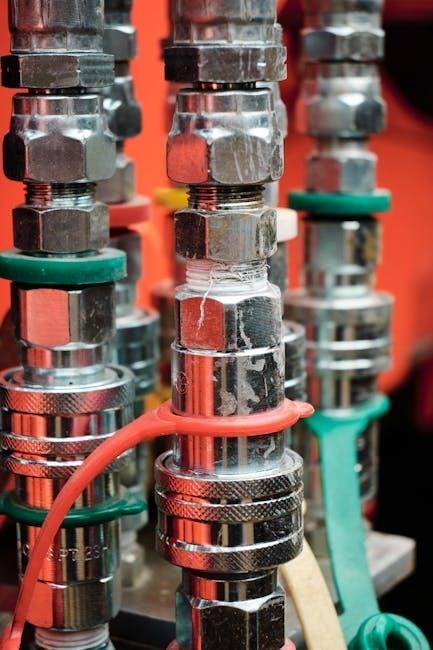
Sears pedal tractors represent a compelling segment of the market, though generally valued below John Deere models. Assessing demand requires careful consideration of condition and originality. While not as consistently high as Deere, well-preserved Sears tractors attract dedicated collectors seeking a piece of American history.
Market analysis, utilizing platforms like MachineryTrader.com and eBay, reveals fluctuating prices. Factors influencing value include model variations, implement availability, and overall aesthetic appeal. Determining a fair price necessitates thorough research and comparison with recent sales data.
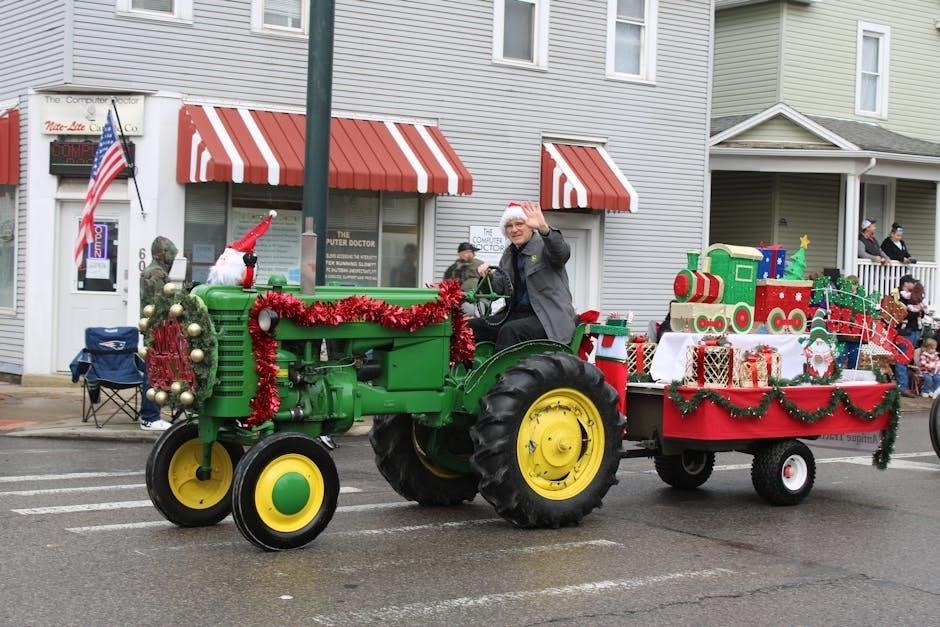
Ertl Pedal Tractors: Originality and Collectibility
Ertl pedal tractors, particularly original models like the John Deere 520 narrow front, command significant attention from collectors. Originality is paramount; any modifications or reproduction parts drastically reduce value. The Ertl John Deere 520, with approximately 40,000 units produced, holds historical importance.
Assessing collectibility involves verifying authenticity – checking for correct decals and markings. A tractor in pristine, original condition, mirroring its initial $1900 price point (adjusted for inflation), will fetch a premium. Auction results on MachineryTrader.com provide valuable pricing benchmarks.
Condition: The Primary Value Driver
Condition overwhelmingly dictates a pedal tractor’s value. A perfectly preserved example commands a substantially higher price than one exhibiting wear and tear. Careful assessment of rust, paint integrity, and decal condition is crucial. Restored tractors can be valuable, but originality often trumps restoration in the eyes of serious collectors.
However, a poorly executed restoration can decrease value. Evaluating the extent of wear – scratches, dents, and fading – provides insight into the tractor’s history and impacts its overall market appeal. Pristine condition equals premium pricing.
Restored vs. Original Condition: Pros and Cons
Restoration can enhance a pedal tractor’s aesthetic appeal, potentially increasing its value to buyers prioritizing appearance. However, purists often favor original condition, even with flaws, valuing authenticity and historical integrity. A professional restoration is costly, and a subpar job can diminish value.
Original tractors, while potentially showing wear, offer a tangible link to the past. Collectors appreciate untouched examples, viewing them as time capsules. The decision hinges on balancing cosmetic improvement with preserving the tractor’s original character and collector desirability.
Assessing Rust, Paint, and Decals
Evaluating condition begins with rust assessment; surface rust is less detrimental than structural rust compromising integrity. Original paint, even faded, is preferable to a poor repaint. Inspect for overspray or incorrect colors. Decals are crucial; original, intact decals significantly boost value, while replacements detract unless expertly replicated.
Minor paint chips are acceptable, reflecting age, but extensive damage lowers value. Carefully examine decal edges for peeling or fading. Document all flaws with photographs for transparency during sales, aiding accurate valuation and buyer confidence;
Impact of Wear and Tear on Value
General wear and tear inevitably affects pedal tractor value, but the extent matters. Moderate use, showing signs of play, is acceptable and expected in vintage toys. However, broken parts, missing components, or significant structural damage drastically reduce worth. Functionality is key; a working tractor commands a higher price.
Assess tire condition, seat integrity, and steering mechanism. Excessive wear suggests harder use and potentially hidden issues. Document all imperfections honestly to build trust with potential buyers and justify the asking price accurately.
Rarity and Production Numbers
Pedal tractor value is significantly influenced by scarcity. Limited edition models or prototypes, produced in small quantities, command premium prices among collectors. Knowing production numbers is crucial; for example, over 40,000 John Deere 520s were made, impacting their relative affordability.
Lower production runs automatically increase desirability. Research specific model years, as some were produced for shorter periods. Documentation proving limited availability—factory records or original marketing materials—substantially boosts a tractor’s investment potential and overall market value.
Limited Edition and Prototype Models
Limited edition pedal tractors, often released for anniversaries or special events, represent the pinnacle of collectibility. These frequently feature unique paint schemes, decals, or accessories not found on standard production models, driving up demand. Prototypes, even more rare, are pre-production samples, potentially exhibiting design variations.

Authenticating these models requires meticulous research and documentation. Provenance—a clear ownership history—is vital. Expect significant premiums for verified limited editions or prototypes, as they represent a unique piece of pedal tractor history and attract serious collectors willing to invest.
Production Years and Their Influence
The year a pedal tractor was manufactured significantly impacts its value. Earlier production runs, particularly those from the 1950s and 1960s, often command higher prices due to scarcity and nostalgic appeal. Later models, while potentially more common, may still be valuable depending on the brand and specific features.
Production numbers declined over time, making certain years rarer than others. Knowing the total units produced during a specific year helps assess a tractor’s exclusivity; Researching historical production data is crucial for accurate valuation, considering market trends and collector preferences.
Specific Model Variations and Their Value
Distinct model variations within a brand dramatically influence pedal tractor value. For instance, John Deere’s narrow front tractors often fetch higher prices than their wide front counterparts, appealing to collectors seeking specific aesthetics. Implement availability also plays a key role; tractors with original, matching implements are considerably more valuable.
Rare variations, like limited-edition paint schemes or unique features, command premiums. Understanding these nuances requires detailed research into each model’s production history and identifying features that enhance collectibility and desirability within the hobby.
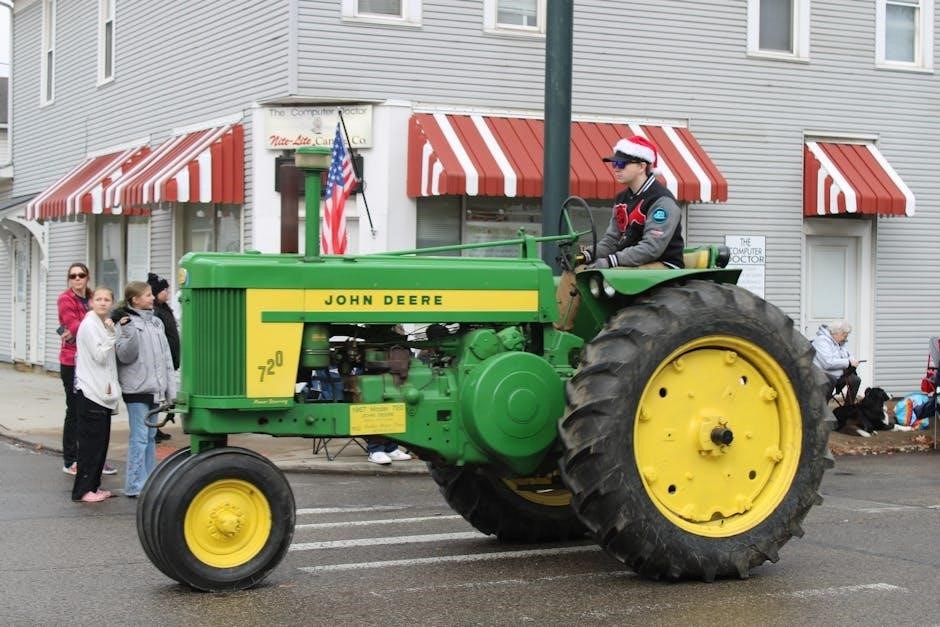
Narrow Front vs. Wide Front Tractors
The distinction between narrow and wide front pedal tractors significantly impacts market value, particularly within the John Deere lineage. Narrow front models, like the Ertl John Deere 520, are often more sought after by collectors due to their historical accuracy and aesthetic appeal. This preference drives up their prices compared to wide front versions.
However, condition and originality remain paramount. A pristine wide front tractor can still exceed the value of a poorly maintained narrow front. Understanding collector preferences and specific model desirability is crucial for accurate appraisal.
Implement Availability and Impact on Price
The presence of original implements dramatically influences a pedal tractor’s value. Complete sets – including plows, planters, or wagons – command a substantial premium over tractors sold alone. Scarcity plays a key role; rarer implements significantly boost the overall price. Collectors actively seek these accessories to enhance display authenticity and completeness.
Even the condition of implements matters. Well-maintained, original implements contribute more value than damaged or reproduction parts. Assessing implement availability and condition is vital for accurate valuation.
Pedal Tractor Auctions and Sales Data
Analyzing recent auction results from platforms like MachineryTrader.com provides crucial insights into current market values. Observing completed sales – particularly for comparable models and conditions – establishes realistic price expectations. Online marketplaces, such as eBay, offer a broader range of data, reflecting diverse seller pricing and buyer demand.
Tracking sales trends reveals fluctuations influenced by seasonality and collector interest. Remember shipping costs significantly impact final prices, especially for larger items like pedal tractors, limiting broader market access.
Analyzing Recent Auction Results (MachineryTrader.com)
MachineryTrader.com consistently features original Ertl John Deere 520 narrow front pedal tractors, offering valuable data points. Recent auctions demonstrate that condition is paramount; well-preserved tractors command premium prices. Observing final sale prices, including buyer’s premiums, provides a realistic assessment of market value.
Detailed descriptions and accompanying photographs are essential for accurate comparisons. Pay close attention to any noted restorations or missing parts, as these significantly influence the final bid. Tracking multiple sales establishes a reliable price range for similar models.
Online Marketplaces: eBay and Similar Platforms
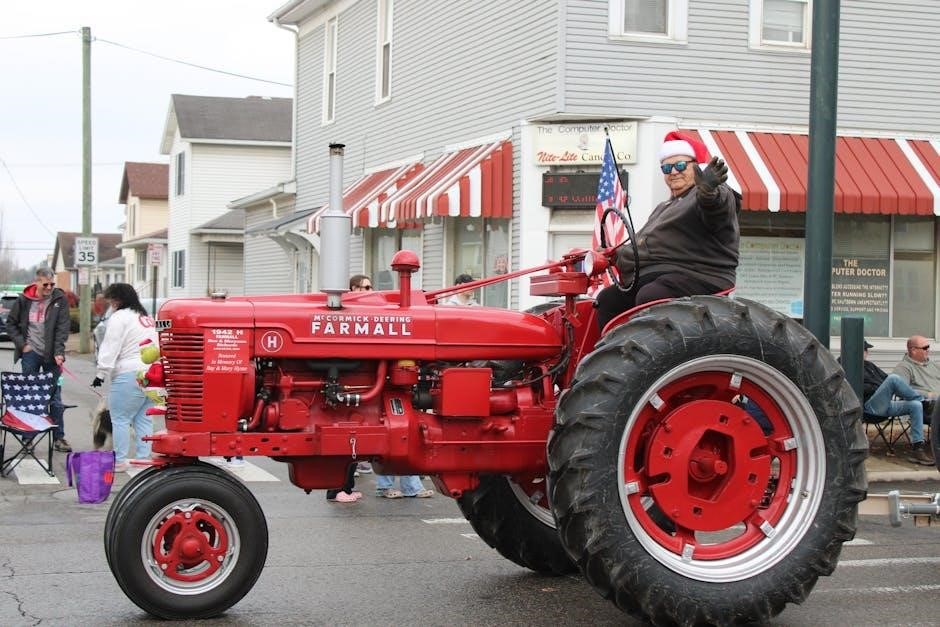
eBay serves as a dynamic marketplace for pedal tractors, showcasing a wide range of models and conditions. Completed listings are invaluable for gauging current market trends and establishing realistic price expectations. Unlike auction sites, fixed-price listings offer immediate purchase options, but may lack the potential for bargains.
Carefully review seller feedback and detailed descriptions, paying attention to shipping costs – a significant factor due to dimensional weight. Comparing similar tractors across multiple platforms ensures a competitive price assessment. Remember to factor in potential restoration costs when evaluating value.
Restoration Costs vs. Value Increase
Restoring a pedal tractor can be a significant investment, potentially exceeding the tractor’s current market value. Professional restoration services offer expertise but come at a premium cost. DIY restoration is more affordable, but requires skill, time, and sourcing authentic parts.
Consider the impact of restoration on originality; some collectors prefer original condition, even with wear. A well-executed restoration can increase value, but overspending negates potential profits. Thoroughly research costs before commencing, and prioritize preserving original decals whenever possible.
Professional Restoration Services
Engaging professional restorers offers a comprehensive solution for bringing a pedal tractor back to its former glory. These services typically include media blasting to remove rust, expert paint application matching original colors, and meticulous decal replacement using accurate reproductions.
However, professional restoration comes at a substantial cost, often ranging from several hundred to over a thousand dollars depending on the tractor’s condition and complexity. Obtain multiple quotes and carefully review the restorer’s experience and portfolio before committing. Ensure they understand the nuances of pedal tractor restoration.
DIY Restoration Considerations
Undertaking a do-it-yourself restoration can be rewarding, but requires significant time, skill, and investment in tools. Rust removal, paint matching, and decal sourcing demand patience and attention to detail. Improper techniques can diminish a tractor’s value.
Carefully research appropriate paints and restoration methods. Consider the potential for errors and the cost of correcting them. While DIY can save money, a poorly executed restoration may yield a lower return than leaving the tractor in original, albeit worn, condition. Authenticity is key!
Shipping Costs and Geographical Impact
Pedal tractor shipping presents unique challenges due to dimensional weight and size. Costs escalate rapidly, particularly for distances exceeding the continental US. Shipping to Europe, for example, incurs substantial charges, often making it economically unfeasible.
Dimensional weight calculations, factoring length, width, and height, significantly impact pricing. Shipping restrictions may also apply. Geographical location influences demand; areas with strong collector bases may see higher prices, offsetting some shipping expenses. Local pickup is often preferred to avoid these complexities.
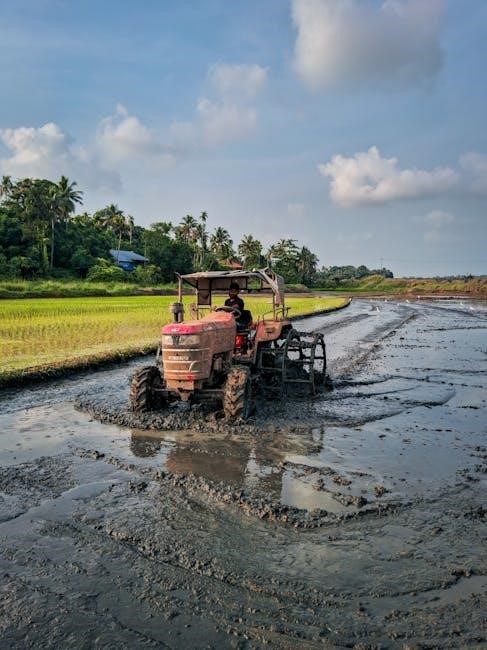
Dimensional Weight and Shipping Restrictions (Continental US)
Within the continental US, shipping a pedal tractor relies heavily on dimensional weight – not actual weight. Carriers calculate costs based on the tractor’s size (length, width, height). This often results in significantly higher fees than anticipated.
Common restrictions involve palletizing and secure packaging requirements. Some carriers may refuse oversized items or require specialized freight services. Obtaining quotes from multiple carriers is crucial. Local freight brokers can often negotiate better rates. Expect higher costs for rural deliveries due to increased mileage and handling.
International Shipping Challenges and Costs
Shipping pedal tractors internationally presents substantial hurdles. Dimensional weight dramatically increases costs, often exceeding the tractor’s value. Import duties, taxes, and brokerage fees vary significantly by destination country, adding unexpected expenses.
Strict customs regulations require extensive paperwork and potential inspections, causing delays. Many carriers avoid shipping large, bulky items overseas. Finding a specialized freight forwarder experienced in international tractor transport is essential. Insurance is crucial, given the risk of damage or loss during transit. Shipping to Europe, for example, is particularly expensive.
Identifying Counterfeit or Reproduction Parts
Authenticity is paramount when assessing pedal tractor value. Counterfeit decals often lack the crispness and detail of originals; examine markings closely for inconsistencies. Reproduction wheels and tires may differ in tread patterns, rubber composition, or hubcap details.
Inspect for modern manufacturing techniques on parts claiming to be vintage. Original paint typically exhibits a specific patina, while reproductions appear too perfect. Research original part numbers and compare them to those on the tractor. Consulting with experienced collectors can help verify authenticity and avoid costly mistakes.
Authenticity Checks for Decals and Markings
Genuine decals possess a distinct clarity and color vibrancy, often fading evenly with age. Counterfeits frequently exhibit blurry printing or incorrect color shades. Carefully examine the adhesive residue – original decals leave a different residue than modern replacements.
Inspect for proper alignment and font styles matching original specifications. Research known decal variations for specific models and production years. Utilize magnification to scrutinize fine details and identify inconsistencies. Comparing decals to documented examples from reputable sources is crucial for accurate authentication.
Recognizing Reproduction Wheels and Tires
Reproduction wheels often lack the casting imperfections and subtle details found in originals. Examine the metal composition and weld points for inconsistencies. Tire sidewall markings on reproductions may differ in font or wording from authentic tires.
Original tires exhibit a specific rubber compound that ages differently than modern materials. Look for consistent wear patterns and appropriate date codes (if present). Inspect the wheel hubs and axle connections for correct manufacturing techniques. Comparing components to known authentic examples is vital for accurate identification.
Current Market Trends in Pedal Tractor Values
The pedal tractor market is experiencing increased demand from collectors, fueled by nostalgia and broader vintage toy trends. John Deere models consistently command premium prices, particularly those in exceptional original condition. Sears tractors are also gaining traction, with market demand steadily rising.
Auction results on platforms like MachineryTrader.com demonstrate strong bidding activity. Online marketplaces, including eBay, showcase a wide range of prices depending on model and condition. This upward trend suggests continued value appreciation for well-preserved and rare pedal tractors.
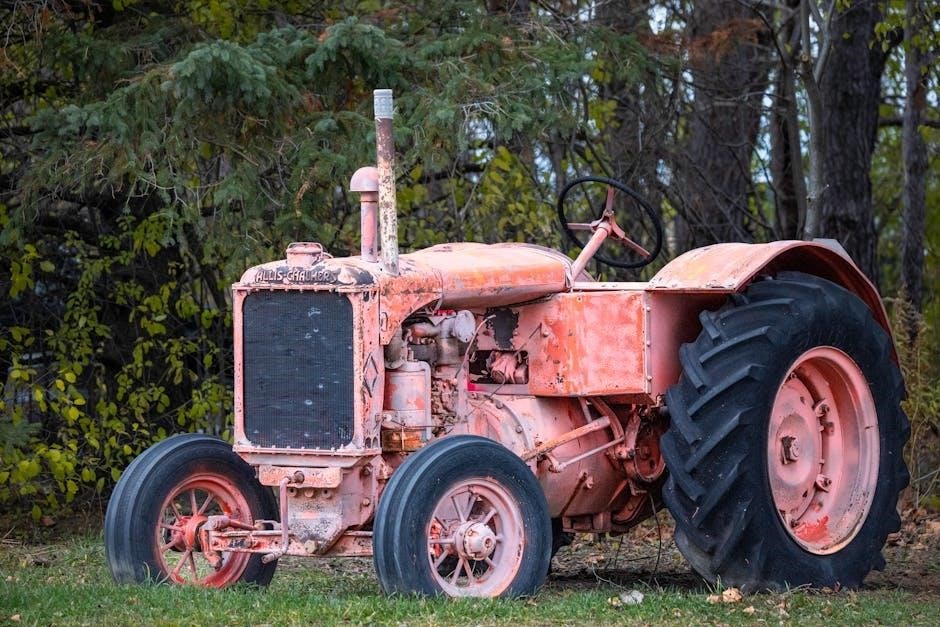
Increasing Demand from Collectors
A significant driver in the rising pedal tractor values is the growing collector base. Nostalgia plays a key role, as many collectors fondly remember these tractors from their childhoods. This emotional connection translates into a willingness to pay premium prices for authentic, well-maintained pieces.
The vintage toy market, as a whole, is experiencing increased interest, further boosting demand. Collectors actively seek specific models, particularly John Deere and Ertl originals, driving competition at auctions and online sales platforms. This trend indicates sustained growth in the hobby.
Impact of Nostalgia and Vintage Toy Trends
The surge in pedal tractor values is deeply intertwined with broader trends in vintage toy collecting and a powerful wave of nostalgia. Many collectors are driven by a desire to reconnect with cherished childhood memories, making these tractors highly sought-after items.
This nostalgic appeal fuels demand, particularly for brands like Sears and John Deere, evoking simpler times. The wider vintage toy market’s growth further amplifies this effect, creating a competitive environment where collectors are willing to invest in quality pieces.
